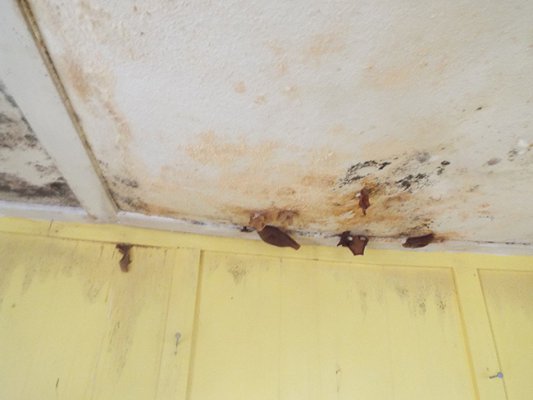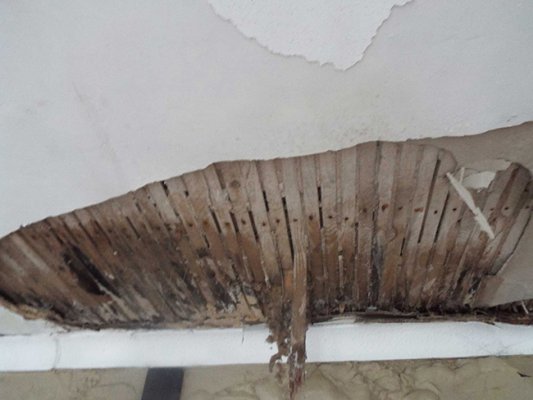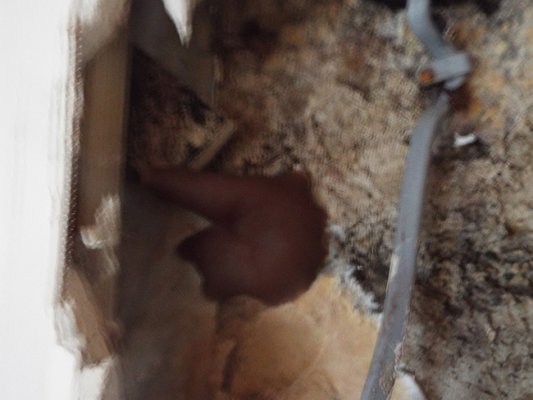Hi,
I joined a while ago regarding another property we were thinking of buying (an old chapel with rising damp); that sale finally fell through after we'd waited around for 6 months but we've just been today to view another property (200 years old - will we ever learn!).
It's an old farmhouse (1808) stone-built, in the middle of nowhere. The exterior walls look solid enough, theres a bit of the black spotty mould here and there and the place could do with a good clean (and a new bathroom, central heating, rewiring, kitchen, floors...the usual stuff).
All was well we thought, but on viewing the interior of the property we discovered that it was fungus city in there!
Quite apart from the usual black spotty mould that you'd expect in any old property that's been left uninhabited for a while; downstairs the exposed ceiling beams in the kitchen and dining room are completely covered with flecks of orange and white mould; the wall in the dining room behind the panelling feels damp and there's some very freaky looking stuff hanging from the ceiling ,
,
where the conservatory (upvc) joins the exterior wall has frills of orange stuff decking it as well
Upstairs in the bedrooms, there's white stuff on quite a lot of the woodwork in one part of the house, the ceiling in one bedroom is sopping wet, and also there's a couple of huge orange mango shaped mounds (actually the colour is exactly that of tinned peaches!) above a couple of the bedroom doors and the plaster has been eaten away.
and also there's a couple of huge orange mango shaped mounds (actually the colour is exactly that of tinned peaches!) above a couple of the bedroom doors and the plaster has been eaten away. 
The floor of the bedroom with the sopping ceiling squelches when you walk across it, and the wall in that bedroom is absolutely sopping as well.
Now - as I've become a little bit more experienced in these things - I did notice that where the mould/fungus/sopping wet walls and floor etc is, seems to be right under where the cold water tank was situated in the loft and so I'm wondering if there was a burst/leak/spillage at some point which has caused the mould to take hold. The dining room is also below the bedroom where the mould/fungus is the worst too.
I've done some research on the net and it looks like dry rot but I'm not 100 percent sure.
The problem with the property is this. It's a repossession. The auction for it is in a couple of days time and the estate agents doing the viewings have only been hired by the auction company for two viewings - of which the second was today. We are hoping that nobody would bid on the property and then we could nip in with an offer on it (because we do love it). But, the short timescale means that we're going to be pushed for time to get the results of the survey back before we (hopefully) make an offer.
So I was wondering...does anyone know what this is? Is it dry rot? Is it wet rot? And how horrible would it be to fix? I've already figured that the whole of the upstairs floors and joists will need to be replaced...
Any advice gratefully received
thank you
I joined a while ago regarding another property we were thinking of buying (an old chapel with rising damp); that sale finally fell through after we'd waited around for 6 months but we've just been today to view another property (200 years old - will we ever learn!).
It's an old farmhouse (1808) stone-built, in the middle of nowhere. The exterior walls look solid enough, theres a bit of the black spotty mould here and there and the place could do with a good clean (and a new bathroom, central heating, rewiring, kitchen, floors...the usual stuff).
All was well we thought, but on viewing the interior of the property we discovered that it was fungus city in there!
Quite apart from the usual black spotty mould that you'd expect in any old property that's been left uninhabited for a while; downstairs the exposed ceiling beams in the kitchen and dining room are completely covered with flecks of orange and white mould; the wall in the dining room behind the panelling feels damp and there's some very freaky looking stuff hanging from the ceiling
 ,
, where the conservatory (upvc) joins the exterior wall has frills of orange stuff decking it as well
Upstairs in the bedrooms, there's white stuff on quite a lot of the woodwork in one part of the house, the ceiling in one bedroom is sopping wet,
 and also there's a couple of huge orange mango shaped mounds (actually the colour is exactly that of tinned peaches!) above a couple of the bedroom doors and the plaster has been eaten away.
and also there's a couple of huge orange mango shaped mounds (actually the colour is exactly that of tinned peaches!) above a couple of the bedroom doors and the plaster has been eaten away. 
The floor of the bedroom with the sopping ceiling squelches when you walk across it, and the wall in that bedroom is absolutely sopping as well.
Now - as I've become a little bit more experienced in these things - I did notice that where the mould/fungus/sopping wet walls and floor etc is, seems to be right under where the cold water tank was situated in the loft and so I'm wondering if there was a burst/leak/spillage at some point which has caused the mould to take hold. The dining room is also below the bedroom where the mould/fungus is the worst too.
I've done some research on the net and it looks like dry rot but I'm not 100 percent sure.
The problem with the property is this. It's a repossession. The auction for it is in a couple of days time and the estate agents doing the viewings have only been hired by the auction company for two viewings - of which the second was today. We are hoping that nobody would bid on the property and then we could nip in with an offer on it (because we do love it). But, the short timescale means that we're going to be pushed for time to get the results of the survey back before we (hopefully) make an offer.
So I was wondering...does anyone know what this is? Is it dry rot? Is it wet rot? And how horrible would it be to fix? I've already figured that the whole of the upstairs floors and joists will need to be replaced...
Any advice gratefully received
thank you
